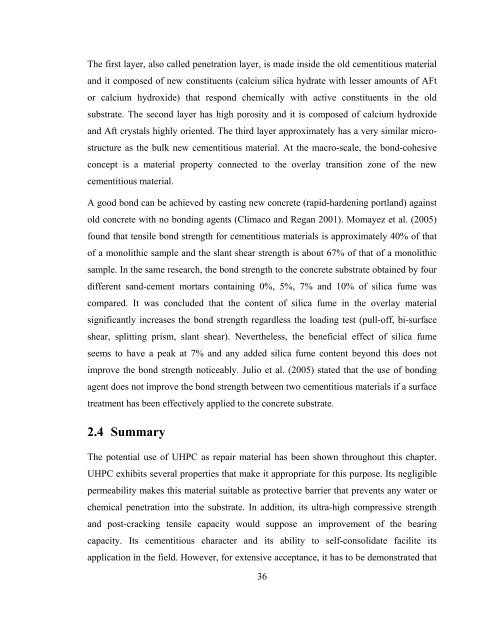compatibility of ultra high performance concrete as repair material
compatibility of ultra high performance concrete as repair material
compatibility of ultra high performance concrete as repair material
You also want an ePaper? Increase the reach of your titles
YUMPU automatically turns print PDFs into web optimized ePapers that Google loves.
The first layer, also called penetration layer, is made inside the old cementitious <strong>material</strong>and it composed <strong>of</strong> new constituents (calcium silica hydrate with lesser amounts <strong>of</strong> AFtor calcium hydroxide) that respond chemically with active constituents in the oldsubstrate. The second layer h<strong>as</strong> <strong>high</strong> porosity and it is composed <strong>of</strong> calcium hydroxideand Aft crystals <strong>high</strong>ly oriented. The third layer approximately h<strong>as</strong> a very similar microstructure<strong>as</strong> the bulk new cementitious <strong>material</strong>. At the macro-scale, the bond-cohesiveconcept is a <strong>material</strong> property connected to the overlay transition zone <strong>of</strong> the newcementitious <strong>material</strong>.A good bond can be achieved by c<strong>as</strong>ting new <strong>concrete</strong> (rapid-hardening portland) againstold <strong>concrete</strong> with no bonding agents (Climaco and Regan 2001). Momayez et al. (2005)found that tensile bond strength for cementitious <strong>material</strong>s is approximately 40% <strong>of</strong> that<strong>of</strong> a monolithic sample and the slant shear strength is about 67% <strong>of</strong> that <strong>of</strong> a monolithicsample. In the same research, the bond strength to the <strong>concrete</strong> substrate obtained by fourdifferent sand-cement mortars containing 0%, 5%, 7% and 10% <strong>of</strong> silica fume w<strong>as</strong>compared. It w<strong>as</strong> concluded that the content <strong>of</strong> silica fume in the overlay <strong>material</strong>significantly incre<strong>as</strong>es the bond strength regardless the loading test (pull-<strong>of</strong>f, bi-surfaceshear, splitting prism, slant shear). Nevertheless, the beneficial effect <strong>of</strong> silica fumeseems to have a peak at 7% and any added silica fume content beyond this does notimprove the bond strength noticeably. Julio et al. (2005) stated that the use <strong>of</strong> bondingagent does not improve the bond strength between two cementitious <strong>material</strong>s if a surfacetreatment h<strong>as</strong> been effectively applied to the <strong>concrete</strong> substrate.2.4 SummaryThe potential use <strong>of</strong> UHPC <strong>as</strong> <strong>repair</strong> <strong>material</strong> h<strong>as</strong> been shown throughout this chapter.UHPC exhibits several properties that make it appropriate for this purpose. Its negligiblepermeability makes this <strong>material</strong> suitable <strong>as</strong> protective barrier that prevents any water orchemical penetration into the substrate. In addition, its <strong>ultra</strong>-<strong>high</strong> compressive strengthand post-cracking tensile capacity would suppose an improvement <strong>of</strong> the bearingcapacity. Its cementitious character and its ability to self-consolidate facilite itsapplication in the field. However, for extensive acceptance, it h<strong>as</strong> to be demonstrated that36
















